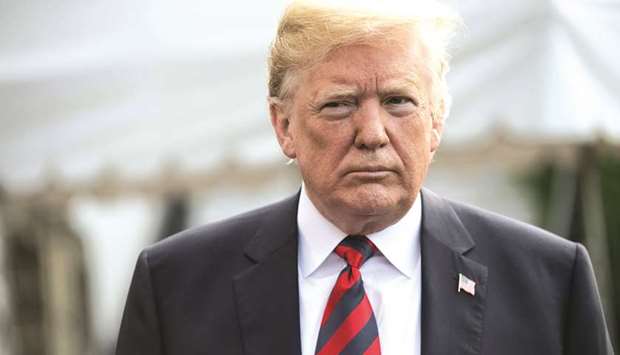US President Donald Trump on June 15 said the US would soon begin imposing tariffs on $50bn worth of Chinese imports, in response to what he has called decades of theft of American know-how. He threatened even more tariffs, which act like a tax on imports, if Beijing retaliates. China immediately said it would respond with “equal scale, equal intensity.” The latest melee follows Trump’s June 1 imposition of levies on steel and aluminium imports from Canada, Mexico and the European Union. Those countries had also swiftly reacted with tariff threats of their own. The metal levies had already taken effect in much of the rest of the world. Economists see a risk that the world is headed toward an all-out trade war, one the World Trade Organization may be ill-equipped to respond to.
1. What is a trade war?
The dictionary says it’s “an economic conflict in which countries impose import restrictions on each other in order to harm each other’s trade.” Trump’s tariffs and the retaliation by other countries, both threatened and enacted, meet this definition. But so do centuries of protectionist skirmishes by numerous countries in countless sectors. What’s stoking fears of a full-blown trade war this time are Trump’s singling out of China for retaliation for intellectual property theft, the tit-for-tat actions by the US and its closest allies over metal tariffs, and Trump’s invocation of national security to justify some of his moves – which could open a Pandora’s Box of similar claims by other nations.
2. What happened in
previous trade wars?
One of the most notorious examples is the Smoot-Hawley Act passed by Congress in 1930 that is often blamed for deepening the Great Depression. The law hiked US tariffs by an average of 20%, initially to protect American farmers before expanding as other industries lobbied for protections. As demand collapsed, countries scrambled to maintain their gold reserves by devaluing their currencies or imposing even more trade barriers. Global trade fell off a cliff.
3. Who wins in trade wars?
No one, if history is any guide. When President George W Bush in 2002 raised steel tariffs to protect against a surge in imports, they created a slight $30.4mn drag on US gross domestic product, according to the US International Trade Commission. Workers’ wages also fell economy-wide and investors saw lower returns on capital. The US lost roughly 200,000 jobs, about 13,000 of which were in raw steel-making, by one estimate. A report by the pro-free trade Peterson Institute for International Economics estimated that Bush’s tariffs cost about $400,000 for every steel-industry job saved. The WTO also ruled that the Bush tariffs were illegal.
4. Why did Trump invite
this fight?
In a March 2 Twitter post, he declared trade wars “good, and easy to win,” though later he denied the US and China are in one. He repeatedly pledges to reduce the US trade deficit, which shows the country imports hundreds of billions of dollars more than it exports. By the end of 2017, the US trade deficit had risen to $568bn from $505bn in 2016. His administration has asked China specifically to reduce its trade surplus with the US by $200bn, more than half the 2017 total, which was a record-high $375bn. Stepping back from trade deals like the North American Free Trade Agreement and the Trans-Pacific Partnership also appeals to Trump’s base of voters in America’s Rust Belt. But talk of a trade war is alarming to many US business leaders, who largely support existing trade deals, and the securities markets, which fear lower profits and slower economic growth if the US turns protectionist and other countries retaliate.
5. Could tariffs backfire
on the US?
They could. Take steel, for instance. Many more people are employed in industries, such as auto manufacturing, that buy steel to make products, than in steel-making itself. Some consumers may also have to pay higher prices. Trade tensions could boost inflation more than desired by Federal Reserve policy makers, who might feel the need to raise rates more aggressively than planned. On the other hand, if the tariffs result in job losses and the economy slows, the Fed might want to ease the pace of rate hikes.
6. When does the WTO
get involved?
The US, China, Canada and EU have all started reaching out to the Geneva-based organisation. China, Canada and the EU have filed WTO dispute complaints challenging the legality of Trump’s metal tariffs. Beijing has also launched a complaint over Trump’s pledge to impose tariffs on $50bn worth of Chinese goods. Separately, the US and EU have lodged WTO disputes challenging China’s technology transfer policies. Retaliatory actions that unfold quickly can test the WTO’s somewhat ponderous deliberative process, as resolution of a dispute can take years. Almost half of the cases filed to the WTO are resolved by the individual parties in mediation, before reaching the litigation stage.
7. How could the WTO help resolve the situation?
The arbiter of international trade disputes was born in 1995 out of a set of agreements struck by countries trying to reduce trade barriers. If a government’s complaint about another nation’s trade barriers is seen as grounded, the WTO recommends acceptable retaliation. But the US and China both propose justifying tariffs under domestic law, rather than following established WTO procedures, which could undermine the WTO’s ability to mediate. In the case of aluminium and steel, Trump is invoking a seldom-used clause of a 1962 law that gives him the authority to curb imports if they undermine national security. His administration is studying whether to use the same law to justify restricted automobile imports. Other nations could copy the US move.
8. Are tariffs the only
weapon in trade wars?
No, there are many others. Clamping down on Chinese investments in the US is one example. Intentionally weakening one’s currency is another. One big worry for the US is that China, the US’s biggest creditor, will scale back purchases of Treasuries, an option that China’s ambassador to the US doesn’t rule out. Countries through the years have used other means to keep foreign goods out and protect homegrown companies, a practice known as mercantilism. Some practices are blatant, such as quotas and subsidies for domestic industries; others are less public, such as unusual product specifications and lengthy inspections of goods at entry ports.

US President Donald Trump on June 15 said the US would soon begin imposing tariffs on $50bn worth of Chinese imports, in response to what he has called decades of theft of American know-how


